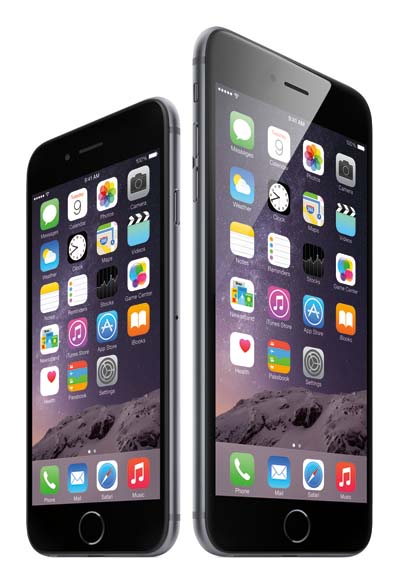Apple Announces iPhone 6 & iPhone 6 Plus—The Biggest Advancements in iPhone History
Dramatically Thin Design Features Stunning Retina HD Displays, Powerful A8 Chip and Advanced Cameras
 CUPERTINO, California — 10 September 2014 — Apple® today announced iPhone® 6 and iPhone 6 Plus, the biggest advancements in iPhone history. The two new models feature stunning 4.7-inch and 5.5-inch Retina HD displays, and are packed with innovative technologies in an all-new dramatically thin and seamless design. The new iPhone models feature a precision unibody enclosure of anodised aluminium that conforms seamlessly with the shaped glass of the display, resulting in a completely smooth and continuous surface. iPhone 6 and iPhone 6 Plus are engineered to be the thinnest ever, delivering a bigger display in a design that is still comfortable to hold and easy to use.
CUPERTINO, California — 10 September 2014 — Apple® today announced iPhone® 6 and iPhone 6 Plus, the biggest advancements in iPhone history. The two new models feature stunning 4.7-inch and 5.5-inch Retina HD displays, and are packed with innovative technologies in an all-new dramatically thin and seamless design. The new iPhone models feature a precision unibody enclosure of anodised aluminium that conforms seamlessly with the shaped glass of the display, resulting in a completely smooth and continuous surface. iPhone 6 and iPhone 6 Plus are engineered to be the thinnest ever, delivering a bigger display in a design that is still comfortable to hold and easy to use.
Packed with innovative new technologies, iPhone 6 and iPhone 6 Plus include the Apple-designed A8 chip with second-generation 64-bit desktop-class architecture for blazing-fast performance and power efficiency; advanced iSight® and FaceTime® HD cameras; and ultrafast wireless technologies. Both models include iOS 8, the latest version of the world’s most advanced mobile operating system, featuring a simpler, faster and more intuitive user experience, new Messages and Photos features, the QuickType™ keyboard, a new Health app, Family Sharing and iCloud Drive℠.
“iPhone 6 and iPhone 6 Plus are the biggest advancements in iPhone history,” said Tim Cook, Apple’s CEO. “The iPhone is the most loved smartphone in the world with the highest customer satisfaction in the industry and we are making it much better in every way. Only Apple can combine the best hardware, software and services at this unprecedented level and we think customers are going to love it.”
For the first time iPhone is available in two new sizes: iPhone 6 features a stunning 4.7-inch Retina® HD display with 1334-by-750 resolution, providing 38 per cent more viewing area than iPhone 5s; and iPhone 6 Plus features an even bigger 5.5-inch Retina HD display with 1920-by-1080 resolution, providing 88 per cent more viewing area and nearly three times more pixels than iPhone 5s. The Retina HD displays feature advanced technologies, including higher contrast for deeper blacks and dual-domain pixels for more accurate colours at wider viewing angles.
With second-generation 64-bit desktop-class architecture, the all-new A8 chip offers faster performance and is more energy-efficient, delivering higher sustained performance and great battery life. With Metal™, a new graphics technology in iOS 8, developers can take the performance of the A8 chip even further, bringing console-class 3D games to iPhone. The A8 chip also includes a new, powerful Apple-designed image signal processor that enables advanced camera and video features.
Both models include the M8 motion coprocessor that gathers motion data from the accelerometer, gyroscope and compass, as well as the new barometer, which senses air pressure to determine relative elevation. The M8 motion coprocessor can continuously measure your motion data even when the device is asleep, saving battery life for fitness apps that use the sensors all day. With iOS 8, motion data from the M8 motion coprocessor appears in the Health app, so you can see how many flights of stairs you’ve climbed, or how far you’ve walked or run. Developers can use CoreMotion APIs that take advantage of the M8 motion coprocessor and HealthKit to create apps that help you take better care of your health and fitness.
The iSight camera gets even better with a new sensor that features Focus Pixels for faster autofocus, making it easier to quickly capture any moment. iPhone 6 Plus users will also benefit from optical image stabilisation technology that compensates for hand shake in low light and works with iOS 8 to reduce subject motion. High-definition video on iPhone improves with faster frame rates up to 60 fps for 1080p video and 240 fps for slow motion, as well as continuous autofocus, cinematic video stabilisation and time-lapse video. The FaceTime HD camera now captures over 80 per cent more light with a new sensor, larger

